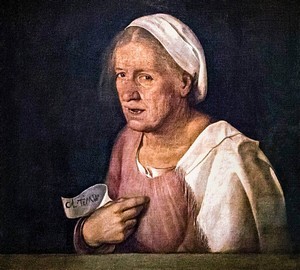
Description of the picture:
The old woman is Giorgione. 1505. Oil on canvas. 68 x 59 cm
The work of the outstanding Venetian master of the Renaissance is full of secrets and white spots. The “Portrait of an Elderly Woman,” which art historians briefly refer to as “The Old Woman,” was no exception. Scientists never doubted the authorship of the picture, but it was not without puzzles. For example, the date when the portrait was painted is unknown, and most importantly, who is depicted on it.
We see a woman of advanced age. The heroine’s hair was slightly disheveled, wrinkles cleared her face, and one can also note an old, sagging nose and a tired look. This look attracts attention most of all – the gaze is directed beyond the picture. The old woman seems to be gazing at us with gaze, a little stern eyes from her own space, where the sixteenth century reigns, having just begun, and knows something about each of the spectators …
You can see in the woman’s hands a sign / sheet of paper / canvas on which you can clearly read: “Col tempo”, which means “over time” or “it happens over time”. The American researcher Erwin Panofsky, comparing the portrait with the painting “Thunderstorm”, expresses the opinion that Giorgione expresses the philosophical idea in this picture that a person is not able to withstand time, whose inevitable force destroys the beauty of youth and youth. Beauty, indeed, is fleeting, like life itself. “Remember old age” – as if Giorgione warns us. The evil irony is that Giorgione himself did not wait for old age – he died of the plague at the age of 30-32.
This old woman does not cause negative emotions or alertness. That is why some people express the opinion that the picture does not warn about old age, but glorifies it. In old age, a person becomes wise and approaches God. So the “Old Woman” may well be a kind of ode to advanced years.
As the painter accurately portrayed a woman unknown to us, not a single wrinkle, dry senile hands, neck with slightly saggy skin escaped his gaze. The old woman’s mouth is open and it seems that it is from heavy breathing. To emphasize the heroine’s yellowed skin, the author dressed her in a white shawl, and threw a thin shawl of the same color on his shoulders.
Giorgione focused on the color mix of brown and white, leaving the background completely black to make the heroine look even more expressive and emotional.
In this picture, Giorgione appears as the successor of portrait realism, the followers of which were many artists, especially Gericault, but in the predecessors, Dürer, Da Vinci, Mantegna and others can be noted."